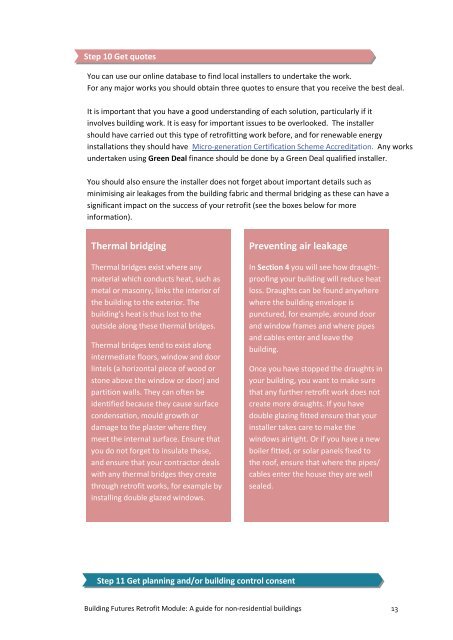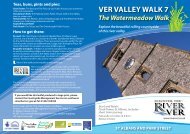Retrofitting: A guide for non-residential buildings
Retrofitting: A guide for non-residential buildings
Retrofitting: A guide for non-residential buildings
You also want an ePaper? Increase the reach of your titles
YUMPU automatically turns print PDFs into web optimized ePapers that Google loves.
Step 10 Get quotes<br />
You can use our to find local installers to undertake the work.<br />
For any major works you should obtain three quotes to ensure that you receive the best deal.<br />
It is important that you have a good understanding of each solution, particularly if it<br />
involves building work. It is easy <strong>for</strong> important issues to be overlooked. The installer<br />
should have carried out this type of retrofitting work be<strong>for</strong>e, and <strong>for</strong> renewable energy<br />
installations they should have -generation Certification Scheme Accreditation. Any works<br />
undertaken using Green Deal finance should be done by a Green Deal qualified installer.<br />
You should also ensure the installer does not <strong>for</strong>get about important details such as<br />
minimising air leakages from the building fabric and thermal bridging as these can have a<br />
significant impact on the success of your retrofit (see the boxes below <strong>for</strong> more<br />
in<strong>for</strong>mation).<br />
Thermal bridging<br />
Thermal bridges exist where any<br />
material which conducts heat, such as<br />
metal or masonry, links the interior of<br />
the building to the exterior. The<br />
building’s heat is thus lost to the<br />
outside along these thermal bridges.<br />
Thermal bridges tend to exist along<br />
intermediate floors, window and door<br />
lintels (a horizontal piece of wood or<br />
stone above the window or door) and<br />
partition walls. They can often be<br />
identified because they cause surface<br />
condensation, mould growth or<br />
damage to the plaster where they<br />
meet the internal surface. Ensure that<br />
you do not <strong>for</strong>get to insulate these,<br />
and ensure that your contractor deals<br />
with any thermal bridges they create<br />
through retrofit works, <strong>for</strong> example by<br />
installing double glazed windows.<br />
Preventing air leakage<br />
In Section 4 you will see how draughtproofing<br />
your building will reduce heat<br />
loss. Draughts can be found anywhere<br />
where the building envelope is<br />
punctured, <strong>for</strong> example, around door<br />
and window frames and where pipes<br />
and cables enter and leave the<br />
building.<br />
Once you have stopped the draughts in<br />
your building, you want to make sure<br />
that any further retrofit work does not<br />
create more draughts. If you have<br />
double glazing fitted ensure that your<br />
installer takes care to make the<br />
windows airtight. Or if you have a new<br />
boiler fitted, or solar panels fixed to<br />
the roof, ensure that where the pipes/<br />
cables enter the house they are well<br />
sealed.<br />
Step 11 Get planning and/or building control consent<br />
Building Futures Retrofit Module: A <strong>guide</strong> <strong>for</strong> <strong>non</strong>-<strong>residential</strong> <strong>buildings</strong> 13
















